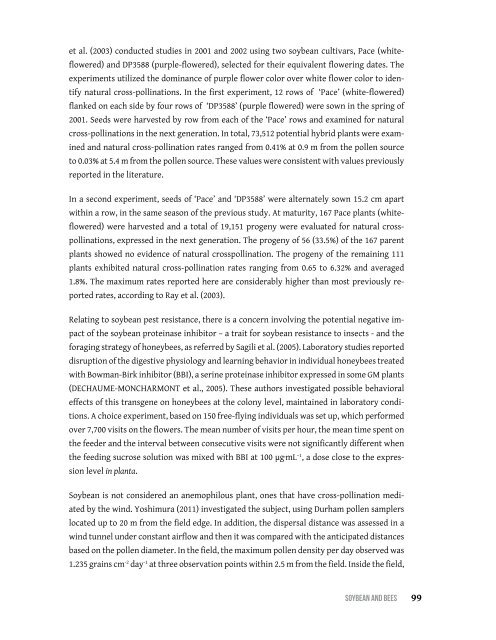Soybean and Bees
You also want an ePaper? Increase the reach of your titles
YUMPU automatically turns print PDFs into web optimized ePapers that Google loves.
et al. (2003) conducted studies in 2001 <strong>and</strong> 2002 using two soybean cultivars, Pace (whiteflowered)<br />
<strong>and</strong> DP3588 (purple-flowered), selected for their equivalent flowering dates. The<br />
experiments utilized the dominance of purple flower color over white flower color to identify<br />
natural cross-pollinations. In the first experiment, 12 rows of ‘Pace’ (white-flowered)<br />
flanked on each side by four rows of ‘DP3588’ (purple flowered) were sown in the spring of<br />
2001. Seeds were harvested by row from each of the ‘Pace’ rows <strong>and</strong> examined for natural<br />
cross-pollinations in the next generation. In total, 73,512 potential hybrid plants were examined<br />
<strong>and</strong> natural cross-pollination rates ranged from 0.41% at 0.9 m from the pollen source<br />
to 0.03% at 5.4 m from the pollen source. These values were consistent with values previously<br />
reported in the literature.<br />
In a second experiment, seeds of ‘Pace’ <strong>and</strong> ‘DP3588’ were alternately sown 15.2 cm apart<br />
within a row, in the same season of the previous study. At maturity, 167 Pace plants (whiteflowered)<br />
were harvested <strong>and</strong> a total of 19,151 progeny were evaluated for natural crosspollinations,<br />
expressed in the next generation. The progeny of 56 (33.5%) of the 167 parent<br />
plants showed no evidence of natural crosspollination. The progeny of the remaining 111<br />
plants exhibited natural cross-pollination rates ranging from 0.65 to 6.32% <strong>and</strong> averaged<br />
1.8%. The maximum rates reported here are considerably higher than most previously reported<br />
rates, according to Ray et al. (2003).<br />
Relating to soybean pest resistance, there is a concern involving the potential negative impact<br />
of the soybean proteinase inhibitor – a trait for soybean resistance to insects - <strong>and</strong> the<br />
foraging strategy of honeybees, as referred by Sagili et al. (2005). Laboratory studies reported<br />
disruption of the digestive physiology <strong>and</strong> learning behavior in individual honeybees treated<br />
with Bowman-Birk inhibitor (BBI), a serine proteinase inhibitor expressed in some GM plants<br />
(Dechaume-Moncharmont et al., 2005). These authors investigated possible behavioral<br />
effects of this transgene on honeybees at the colony level, maintained in laboratory conditions.<br />
A choice experiment, based on 150 free-flying individuals was set up, which performed<br />
over 7,700 visits on the flowers. The mean number of visits per hour, the mean time spent on<br />
the feeder <strong>and</strong> the interval between consecutive visits were not significantly different when<br />
the feeding sucrose solution was mixed with BBI at 100 μg·mL –1 , a dose close to the expression<br />
level in planta.<br />
<strong>Soybean</strong> is not considered an anemophilous plant, ones that have cross-pollination mediated<br />
by the wind. Yoshimura (2011) investigated the subject, using Durham pollen samplers<br />
located up to 20 m from the field edge. In addition, the dispersal distance was assessed in a<br />
wind tunnel under constant airflow <strong>and</strong> then it was compared with the anticipated distances<br />
based on the pollen diameter. In the field, the maximum pollen density per day observed was<br />
1.235 grains cm -2 day -1 at three observation points within 2.5 m from the field. Inside the field,<br />
SoybeAn <strong>and</strong> bees<br />
99


